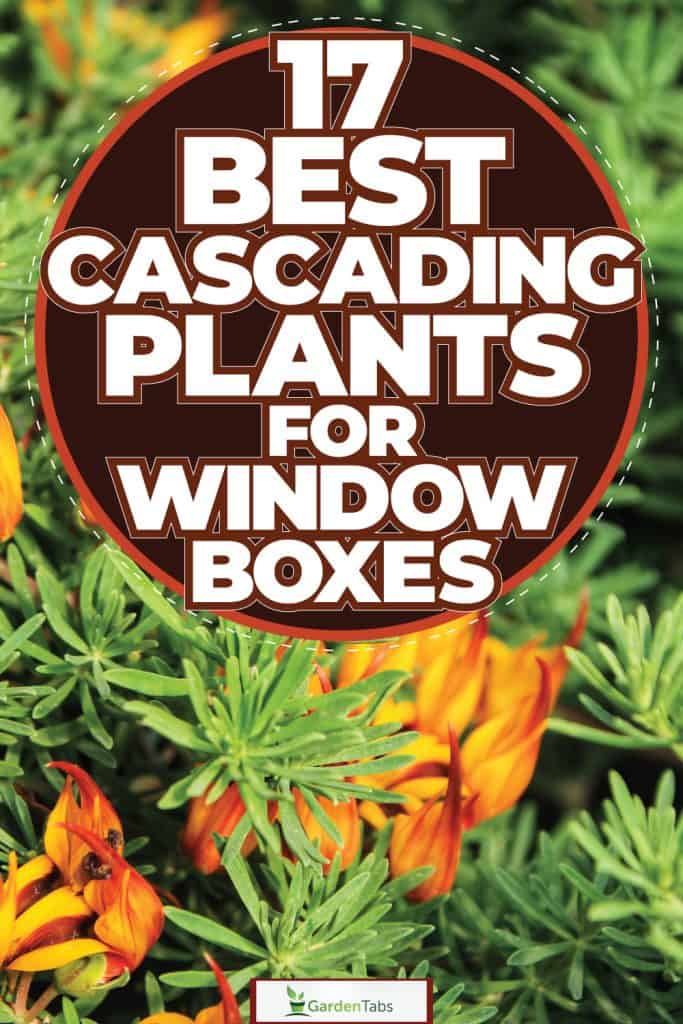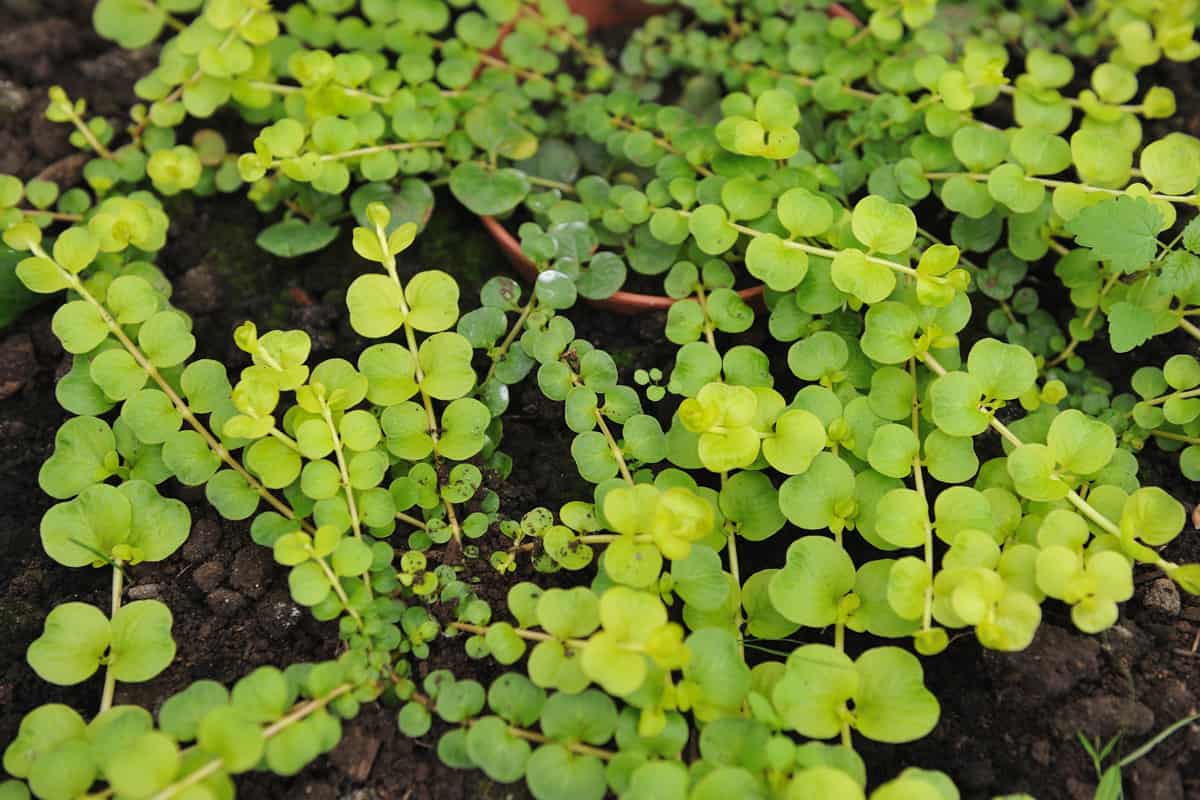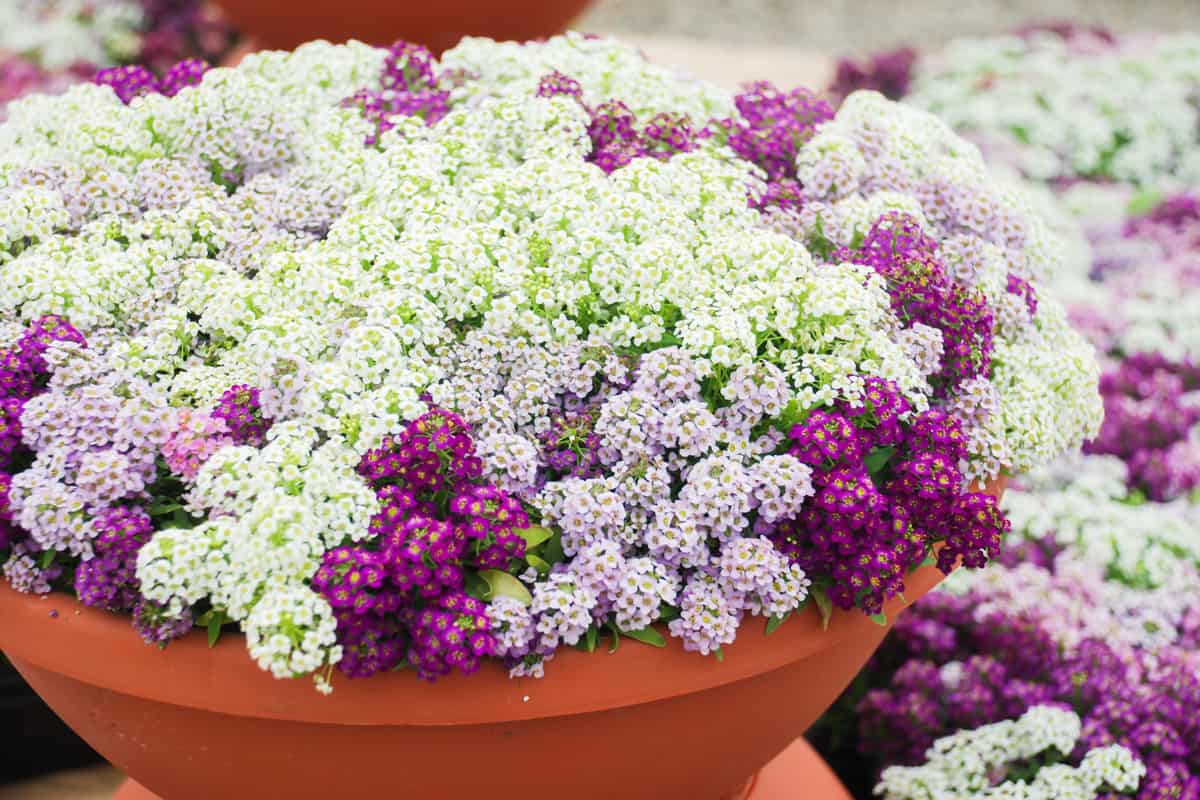Wondering what to plant in your window box? Flowers in window boxes can add curb appeal and beautify your home on a small budget and with little effort. Window boxes look best if they are packed with plants, especially cascading plants.
You will want to consider things like what USDA Hardiness Zone you are in and whether you want perennials or annuals. Or, how much sun this particular location gets. Have no fear! Here are 17 amazing ideas for cascading plants for window boxes. You won't want to miss this one!

1. English Ivy
English ivy is an evergreen, climbing vine that will trail beautifully over your window box. It prefers shade to partial shade and is drought tolerant. Well-drained soil is recommended. Ivy doesn't need a ton of watering—only when the soil is dry to the touch.

The best time to plant English ivy is in the spring. Plant this ivy next to other color blooms and you will have a stunning show-stopper. This perennial grows quickly and can climb up to 80 feet high. Having said that, this plant has been known to harm brick and trees, so plant accordingly to avoid damage.
Click here to see English ivy plants on Amazon.
2. Sweet Potato Vine

Sweet potato vine is sensational for container gardening. It is a fast-growing perennial that can reach up to 10 feet long. It easily tumbles over containers, climbs up a trellis, and can even be used as a ground cover. Sweet potato vine looks fantastic next to bright red coleus.
They do best with at least six hours of sun but can tolerate partial shade. Plant them in well-draining soil in the spring for the best results. Water once a week so as not to let the soil completely dry out. Up the watering during heat waves.
3. Creeping Myrtle

Creeping myrtle is a fast-growing perennial that is normally used as a ground cover. Nevertheless, it is used in a window box because of its trailing effect. It has star-like blue flowers that bloom in the spring.
Creeping myrtle will thrive in full sun to partial shade. These tall evergreens don't need a lot of watering and prefer to be on the dry to medium side. They spread six inches tall and up to three feet wide.
4. Clematis

Clematis is one of the most admired flowering vines around. Its trailing effect makes it perfect for a window box. They can spread anywhere from eight to 12 feet, so give them plenty of room to grow.
These vines need six hours of sunlight per day but also require the soil to stay cool. A great way to do this is by putting a layer of mulch over the soil. Furthermore, they only need about an inch of water per week.
Click here to see clematis seeds on Amazon.
5. Fuchsia

Fuchsia is a tropical plant that comes in a variety of shades. They are easy to grow with a few tips. Make sure to give them a sheltered spot away from harsh sun and wind. They do well with moderate sunshine and well-drained soil.
Prune the flowers in spring and pinch the stems to encourage more flowers. Their bell-shaped flowers look lovely in a hanging basket or window box. For watering preferences, keep the soil moist but not soggy.
6. Creeping Jenny

Creeping Jenny is a vigorous perennial that can be invasive. Because of this, they are ideal for window boxes to keep them contained. Creeping Jenny is a great filler plant and pairs well with taller, hardy plants.
Give them plenty of sunlight with afternoon shade. But keep in mind that the leaves can blanch if they get too much sun and not enough water. Water regularly, especially during heat waves.
7. Silver Falls Dichondra

Silver foliage on silver stems. No wonder it is named silver falls! It's an evergreen perennial that many people love because of how easy it is to grow. It can be grown as a ground cover or a trailing plant.
Silver falls is drought and heat tolerant. It prefers medium to dry soil conditions, so be mindful of over watering. Let it soak up the morning sun with some afternoon shade.
8. Lotus Vine

Lotus vine, also known as parrot's beak, is an excellent summer annual for containers. In shocking oranges and reds, it stands out amongst leafy tumbling plants. It is a favorite in USDA Hardiness Zones 10-12 due to its tropical nature.
Lotus vine likes well-draining soil and full sun. Water deeply and let the top layer of soil dry out before watering again. Pro tip—mix sand into the soil to increase grittiness.
9. Petunia

Everyone loves Petunias! These beloved annuals come in many vibrant colors like pink, purple, blue, white, yellow, and red. They are extremely popular in window boxes, trailing anywhere from two to three feet and blooming from spring until frost.
Petunias don't do well in shade. They will need full sun to thrive. Choose high-quality, well-drained soil and water often. Nonetheless, don't allow the soil to stay overly wet.
Click here to see petunia seeds on Amazon.
10. Calibrachoa

Calibrachoas resemble mini Petunias with their small bell-like flowers. They are most commonly called million bells. Calibrachoas has stellar trailing habits, making them a desired choice for window boxes.
It is most commonly grown as an annual but can be grown as a perennial in milder climates. Growing Calibrachoas is fairly easy. They prefer moist, well-drained soil in full sun. Deadheading is not required, as the spent petals will fall automatically.
11. Purple Heart

Purple heart looks great all year in mild climates. Their succulent stems spread about 10 inches tall, creating a spilling effect. To create a dazzling effect, pair them with pink flowers!
Moist and well-drained soil is ideal. Put them in full sun for a happy plant. Here's another tip—purple heart also does well as a house plant!
12. Mandevilla

Mandevilla is a lush, tropical plant full of pink flowers. They are often thought of as annuals because of their cold sensitivity. However, you can bring them inside during the winter to live. Once the temperatures drop below 50 degrees, bring your plant inside for marvelous blooms all year round.
They need sandy, well-draining soil to do their best. Create a mix with potting soil, peat moss, and sand for the finest combination.
13. Nasturtium

Nasturtiums are cheerful flowers you will want to have around in your garden. Their edible flowers are enjoyable and safe for kids to consume. Their vines spill nicely over window boxes or containers, making them a popular choice amongst gardeners.
These beauties require full sun and prefer slightly acidic to neutral soil. Their orange, red, and white blossoms bloom in the summer and fall. For watering recommendations, water regularly throughout the season, but don't over water. They are drought tolerant but prefer to be in moist soil.
Click here to see nasturtium seeds on Amazon.
14. Trailing Lobelia

These mostly blue, tiny flowers are tender perennials but are most often grown as annuals. It grows six to nine inches tall and six to 12 inches wide, all the while spilling beautifully over containers.
Trailing lobelia is easy to grow with little care. They thrive in full sun or part shade in well-drained soil. Evenly water them without letting them dry out.
15. Viola

Violas are easy to spot with their trademarked colorful appearance. It has been said that each little flower has a face! These annuals, or short-lived perennials, do well in cooler climates and bloom well into late fall.
They enjoy the full sun but not the heat. Therefore, plant them in soft shade and water regularly. They prefer slightly acidic soil with rich organic material like peat moss. As long as the weather stays cooler, anywhere from 40 to 70 degrees, you can't go wrong with violas.
16. Alyssum

Alyssum is another cool-season flower. Its tiny, cross-shaped flowers spread magnificently in containers and window boxes. Alyssum can be an invasive perennial given the right conditioners.
It soaks up neutral to acidic soil that is well drained but also evenly moist. Keep things cool with alyssums and give them shade or else they might fade and wither.
Click here to see alyssum seeds on Amazon.
17. Creeping Zinnia

Coming in hot is the creeping zinnia! These pretty, daisy-like flowers are true annuals and die off after the blooming season. It's a low-maintenance plant, making it one of our favorites.
They need full sun and well-drained soil to create blooms in the summer. The great thing about creeping zinnias is that they grow well in all USDA Hardiness Zones.
Wrapping It Up

We have gotten through the top 17 cascading plants for your window boxes! We hope you enjoyed the list and come back when you need some inspiration.

Made it to the end? Check out these related articles:
Climbing Petunia: Care Tips, Shopping Links, and Pictures





